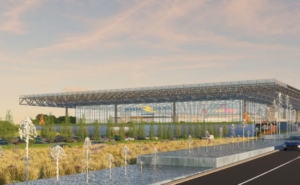Take note of this rapidly expanding government trend
 Adaptive reuse is a terminology, process, and trend that is becoming quite common in government marketplaces.
Adaptive reuse is a terminology, process, and trend that is becoming quite common in government marketplaces.
Public officials throughout the country are launching adaptive reuse projects involving government facilities that already exist. Rather than launch entirely new construction projects, public officials, especially in cities and counties, are choosing to redevelop their backlog of abandoned brownfield facilities, and there are numerous benefits and incentives that attach to these types of projects.
In Chicago, the 50-year-old Lakeside Center has been targeted for an adaptive reuse project. The outdated facility spans 583,000 square feet, and 300,000 square feet of it will soon be converted into casino floorspace. The remaining space will be converted into an area that features food, beverages, and entertainment options. The overall project has been assigned a preliminary budget of $1 billion.
A $24 million adaptive reuse project in Hammond, Indiana, will involve a large, vacant building in the downtown district. The unused facility will be converted into 100 residential units as part of a broader plan to revitalize the city’s urban core and bring more people into an area where retail will be enhanced. This project will be launched this spring.
In Shakopee, Minnesota, a local economic development organization is supporting an adaptive reuse project with property owned by the city. The redevelopment effort will result in a 36,000-square-foot Innovation Center. The repurposed facility will include co-working space, an activity center, and educational space. A recent estimate puts the project’s cost at $12 million. The design phase is underway, and the issuance of solicitation documents is planned for June with construction slated to begin in August.
Officials in Austin, Texas, have allocated $4 million for the design phase of an adaptive reuse project related to an abandoned railroad track. The plan is to transform 6.5 miles of brownfield property into a walking and biking trail that cuts across the southern part of the city. The initiative will be overseen by the Public Works Department. Once design work is 60 percent complete, officials will seek citizen input before proceeding. The project is on a fast track, and solicitation documents will be released for construction work by this summer.
An adaptive reuse project in Umatilla, Oregon, will centralize professional resources for residents. An old post office facility will be upgraded and repurposed to become a business center. The project will involve renovating and expanding the facility for a cost of $7.6 million. An additional wing with two floors will be constructed to house incubator space for local entrepreneurs and long-term rental space for other business-related operations. The facility also will serve as the headquarters for the local Community Development Department. The project is slated to begin in 2022 following completion of design work.
Numerous adaptive reuse projects are underway in California. One notable example is the multi-phase project related to Sacramento Valley’s historic train station. This project’s objective is to create a modernized transit center with surrounding public space. The project will result in the development of a mobility center and an additional 750,000 square feet of commercial space. Work on the initial phase to build out the mobility center is expected to cost $90 million.
State officials in California will also encouraging more adaptive reuse projects by offering grant funding. The state designated $100 million from its general fund for an adaptive reuse program designed to accelerate plans that convert brownfields and abandoned facilities.
The Mount Vernon district of Virginia has secured $3 million for adaptive reuse projects that involve two buildings on the 50-acre Workhouse Campus. The historic Workhouse 13 and Workhouse 15 facilities were used for housing and rehabilitating inmates, but will now be converted into centers for cultural, educational, and community events. The project’s overall cost is expected to reach $8 million, and the hope is that construction can begin later this year.
Another large, adaptive reuse project is planned for the Mount Vernon High School facility. The building, originally constructed in 1939, carries a historical designation so officials will offer historic tax credits to leverage private investment. Costs for the project are estimated at $86 million. The redeveloped brownfield property will be designed to provide a gathering place for vocational training, public meetings, and other citizen-related activities.
The state of Utah also has a program to incentivize private investment in adaptive reuse projects. One planned initiative involves a Salt Lake City train station originally built in 1908. This objective is to convert the brownfield property into a hotel. Because the project is in one of the city’s opportunity zones, private-sector investors also will be able to receive capital gains tax benefits. Construction is planned for later this year.
City officials in Manistee, Michigan, have announced plans to rehabilitate three acres of unused property for the construction of a five-story hotel. The property qualifies as an economically blighted brownfield, so private sector investors in the project will be eligible for tax benefits. Construction is scheduled to begin spring 2022.
The combination of favorable tax benefits as well as the availability of public funding creates immediate private-sector interest. It is safe to predict that many more states will focus aggressively on adaptive reuse projects in the next several years. Contracting firms should monitor these types of opportunities because adaptive reuse projects are destined to become an even larger segment in the public sector marketplace throughout the country.

 512-531-3900
512-531-3900 Request More Info
Request More Info
